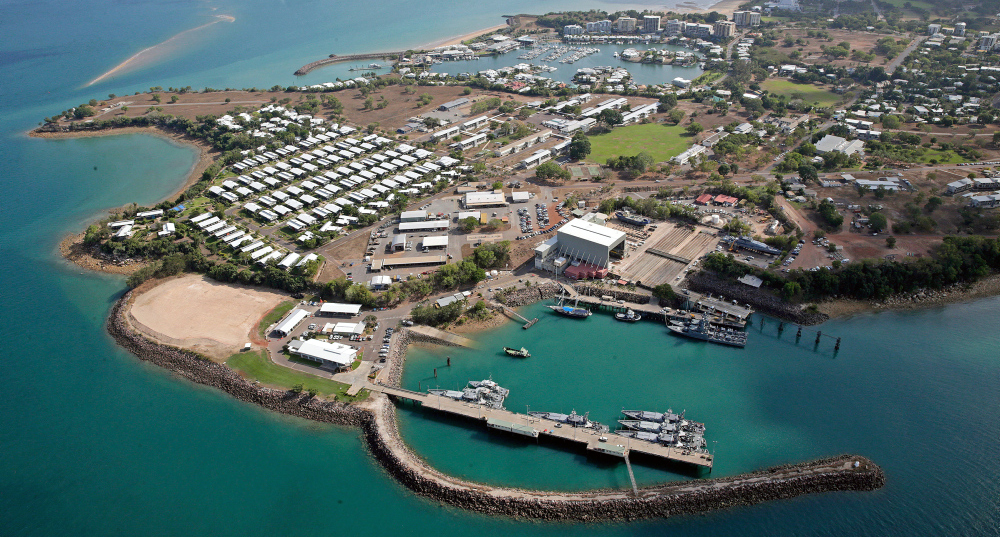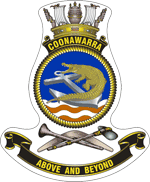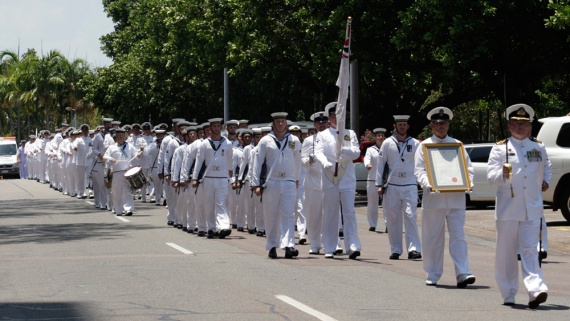HMAS Coonawarra

Commanding Officer: Captain Moses Raudino

Darwin is a vitally important Navy port - a gateway to our northern neighbours and the centre from which we conduct border integrity operations. Darwin plays host to major RAN and multi-national exercises and operations involving around 100 visiting Australian and foreign major warships each year. Currently, almost 600 Navy men and women are based in the Darwin area, most of whom work at Coonawarra or Larrakeyah Barracks, where they are focussed on supporting Fleet operations.
History
During World War I, Darwin had been used as a coaling station by naval vessels, but it was not considered a naval base. While RAN activity continued from this time, the first official naval reserve depot at Darwin was established in January 1935 under Command of Lieutenant Commander HP Jarrett, RAN. At that time, Darwin was part of the Naval Reserve District of Queensland. In 1937, the Naval District of the Northern Territory was separated from the Queensland District and the first District Naval Officer, Lieutenant Commander JH Walker, RAN, was appointed.
At the outbreak of World War II, the naval depot in Darwin was named HMAS Penguin, and on 1 August 1940 was formally commissioned as HMAS Melville.
Throughout the war, Coonawarra Wireless Transmitting Station, which had initially begun operating on 18 September 1939, provided essential communications service in support of Allied operations in the south west Pacific regions. Many of the RAN’s small ships, such as the Fairmile and Harbour Defence Motor Launches, also operated from Darwin and its security was maintained by a complex system of fixed harbour defences, which included an anti-submarine boom net. This was maintained throughout the war by naval boom working vessels.
In the post-war period, as demands for inner city real estate increased, the area of land occupied by HMAS Melville diminished. Consequently, it was decided to decommission Melville but retain the central function of the RAN in Darwin via the Coonawarra Wireless Transmitting Station. HMAS Melville was retained until December 1974 when Cyclone Tracy destroyed it.
Since commissioning on 16 March 1970, HMAS Coonawarra expanded rapidly. A new Receiving Station at Shoal Bay was opened in 1975, and a new Transmitting Station at Humpty Doo became fully operational in October 1982. HMAS Coonawarra relocated from its original site at Berrimah to Larrakeyah in December 2003. The move, closer to the waterfront, better reflected the changing role of Coonawarra from one of a global communications hub, to fleet support.
Today, Darwin’s new naval base is a model of the latest technology for the home porting of patrol boats. The wharf can accommodate six vessels, berthed three abreast. Services such as fuel, electrical power, compressed air, sewerage disposal, oily waste suction, and defueling are available at the berthing points.
The base’s vertical-lift facility further enables patrol boats to be mechanically removed from the water for maintenance and during the cyclone season. This facility has the capability to dock vessels with a draught of up two metres at any tide, and can lift up to 750 tonnes at a rate of 420mm a minute. The service provides much more efficient maintenance for vessels in Northern Australia, thus allowing more time to be spent on coastal surveillance.
Training
Officers who have completed their initial training at HMAS Creswell and are fortunate enough to be posted to Coonawarra, can expect to undertake On the Job (OJT) training, some examples are:
- Navigation training provided by qualified Senior Sailors onboard a patrol boat
- Medical Officer
Divisional system
For all officers and sailors throughout the Navy, the divisional system will be in place for you. Throughout your career you will continue to be managed and supervised by senior personnel, and you will have a Divisional Officer who will be there to give you directions and instructions, provide guidance, advice, discipline and monitor your well-being and morale.
Lifestyle and recreation
Accommodation and meals
Officers posted to Coonawarra will normally be accommodated at the Officers' Mess at Larrakeyah Barracks, during peak periods, or at the Wardroom at Defence Establishment - Berrimah (DEB).
Cabins in the Officer's Mess and Wardroom are quite roomy and serviced daily by defence contractor cleaners.
Breakfast, Lunch and dinner is provided daily, and is of high quality with a variety of choices available, including vegetarian.
Senior and junior sailors posted to Coonawarra are also accommodated at Larrakeyah Barracks or DEB. Cabins at Larrakeyah Barracks and DEB are comfortable and tidy and every sailor has their own personal cabin with a single bed, air conditioning, desk with shelves and a wardrobe. Facilities such as laundry, toilets and showers are shared with other members (including females) of ship's company.
All junior sailors living at Larrakeyah Barracks or DEB take their meals in the cafeteria where meals are served three times per day. A wide variety of wholesome and tasty food is on offer with at least three main choices at every meal including a vegetarian option.
Approval from the Commanding Officer of Coonawarra may be granted to live 'ashore' in non-military accommodation. If approved you will be provided with an allowance to offset the cost of rent.
Facilities at the Officer's Mess at Larrakeyah Barracks include undercover barbeques, a modern 25 metre swimming pool, satellite TV (Austar), air conditioned recreation rooms, table tennis and snooker.
For junior sailors, Larrakeyah Barracks has an Other Ranks mess and recreation facility, allowing all junior sailors to unwind and relax and bring friends (civilian guests) onboard. Facilities include barbeque, swimming pool and snooker.
Bar facilities exist on Larrakeyah Barracks for all ranks and serve alcohol (not to personnel under 18 years of age), however no bar facilities are available for those living on DEB.
Sport
It is a mandatory requirement that all personnel are healthy, fit and active and ready to deploy, and sport is therefore encouraged. Sport is a popular activity for all trainees whether they're really good at it or really bad at it - everyone has a go. A variety of team sports ensure everyone has the chance to show off or learn something new and Departments play against each other regularly.
The ADF is the only organisation that pays you to play sport e.g., Volleyball, Aussie Rules, Cricket and Rugby Union. If you have the skills you can be selected to play for Navy in Inter-Service competitions against Army and RAAF and play all around Australia and possibly overseas.
Larrakeyah Barracks has a modern well equipped gymnasium, which includes weights, cardio machines such as rowing, cycling and walking machines.
Extra-curricular activities
From time to time, trainees will be required to undertake outside activities such as civilian disaster relief and representational duties. Trainees will be required to undertake guard training for specific events, such as Anzac Day, the Bombing of Darwin ceremony and Freedom of Entry marches throughout the Northern Territory.
Leave
If you are not required for duty, and have no service commitments, then personnel can proceed 'ashore' on local evening/overnight leave. Note: If you are under 18 years of age, then you are required to return to quarters before 11:59pm.
Geographical and demographic information
Coonawarra is located two kilometres or about 10 minutes walk from the Darwin city centre. Darwin is a popular tourist destination, boasting several nightclubs, many restaurants, street markets and a Casino. During the dry season, May-October, the famous Mindal Beach markets operate showcasing food, arts and crafts from Australia and South East Asia.
Surrounding Darwin are a number of world class tourist destinations such as the Kakadu and Litchfield National Parks, Katherine Gorge, Adelaide River and there are plenty of other destinations for those willing to travel to some of the most picturesque places in Australia. You will find life in Darwin is unique and has much to offer. It has many attractions of great beauty within easy driving distance and the city offers a relaxed and friendly lifestyle.
Darwin also has a humid climate different to much of Australia for part of the year, the wet season is often hot, very humid and of course wet. The remainder of the year is known as the dry season and is best described as six months of paradise.



